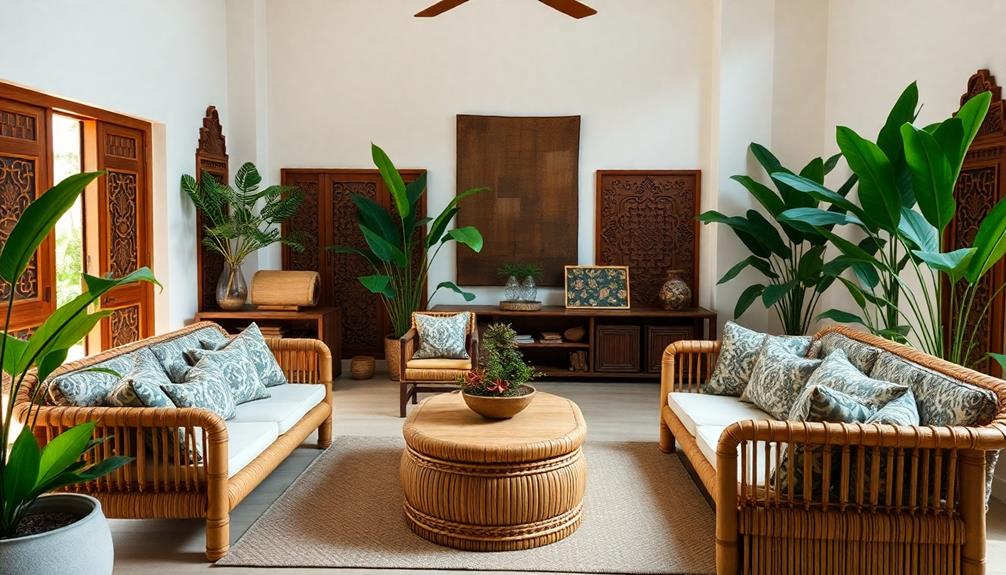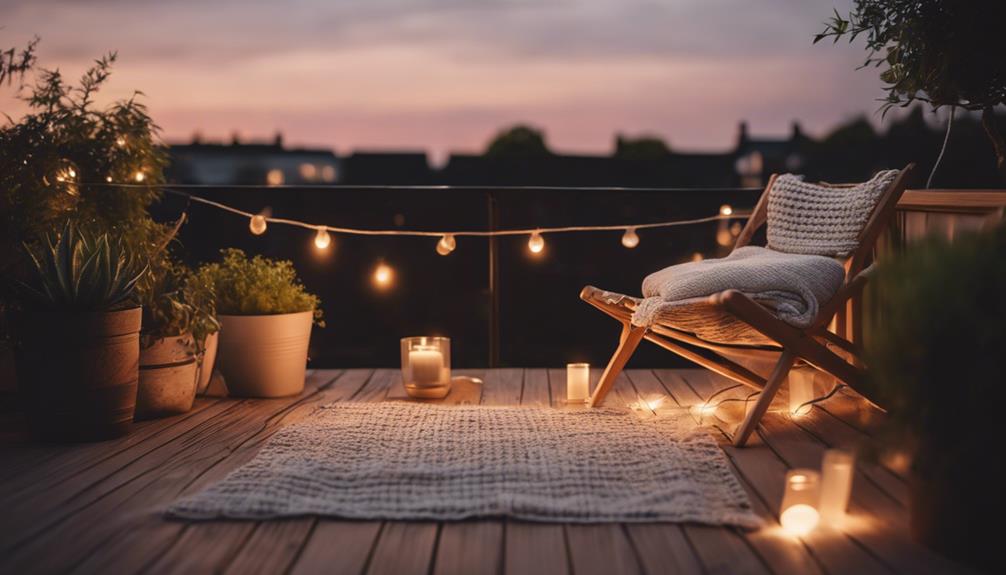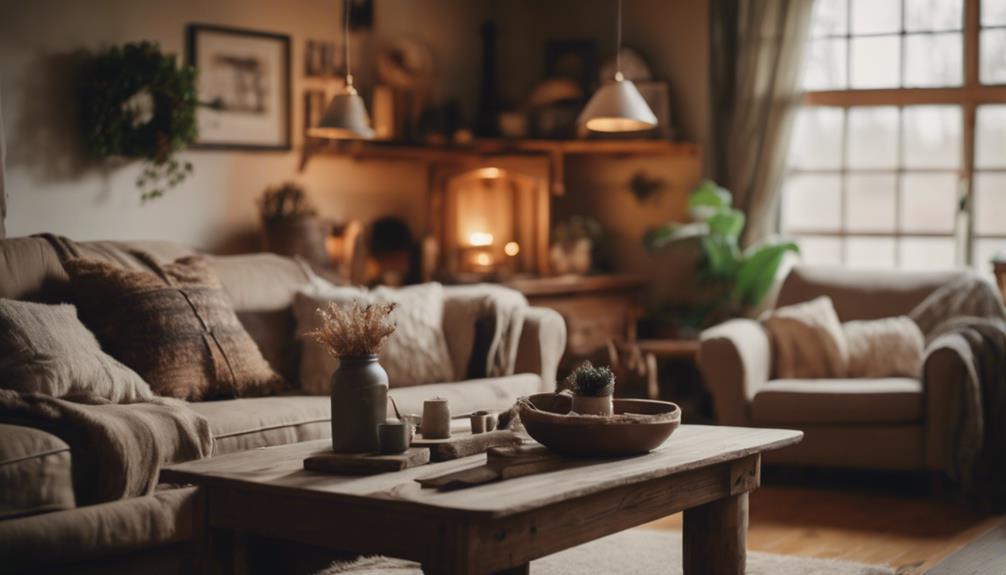When you incorporate elements of Indonesian culture into your interior design, you'll find a vibrant blend of tradition and modernity. Using materials like rattan, bamboo, and intricately carved wood transforms your space while connecting you to nature. You can also enhance your decor with batik textiles, known for their rich patterns, and wayang puppetry, which adds unique character. Earthy color palettes inspired by nature and a focus on sustainable practices reflect Indonesian heritage beautifully. By integrating these elements, you create warm, inviting spaces that celebrate culture. You might discover even more exciting insights about this aesthetic.
Key Takeaways
- Traditional materials like rattan, wood, and bamboo emphasize sustainability and eco-friendliness in modern interior design.
- Intricate batik patterns are adapted into contemporary home decor, blending tradition with modern aesthetics.
- Wood carvings from Bali and Jepara serve as stunning decorative accents, showcasing local artistry and cultural heritage.
- Wayang puppetry and Indonesian decor masks enrich spaces, contributing to cultural storytelling and conversation starters in interiors.
- Earthy color schemes and nature-inspired elements create serene environments, reflecting Indonesia's lush landscapes and enhancing emotional well-being.
Rattan in Modern Design
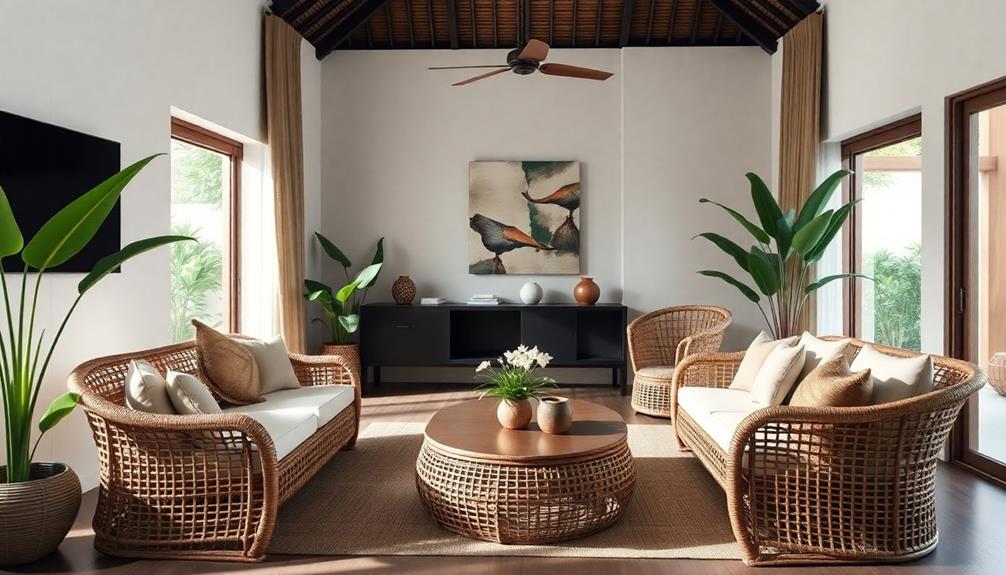
Rattan has become a staple in modern interior design, celebrated for its versatility and eco-friendliness. Sourced primarily from Indonesia, particularly Cirebon, where 80% of the country's rattan enterprises are located, this material embodies both luxury status and sustainability.
When you incorporate rattan into your space, you're not just choosing a stylish element; you're also embracing the organic elements that reflect Indonesian culture. Balinese design characteristics further highlight the use of natural materials like rattan, emphasizing a connection to nature and sustainability.
Rattan's durability makes it a top choice for outdoor furniture, appealing to eco-conscious consumers in Europe and the USA. As you design your interiors, imagine how rattan can seamlessly blend with various aesthetics, adding a natural touch that aligns with contemporary design trends. Its weather resistance means you can enjoy your rattan pieces without worrying about wear and tear.
In upscale residential and commercial spaces, rattan's luxury status shines through, enhancing visual appeal while supporting sustainable practices. By choosing rattan, you contribute to a growing movement that values eco-friendly materials, ensuring your home not only looks good but feels good too.
Embracing rattan in your design choices is a nod to both modernity and the rich heritage of Indonesian craftsmanship.
The Art of Batik
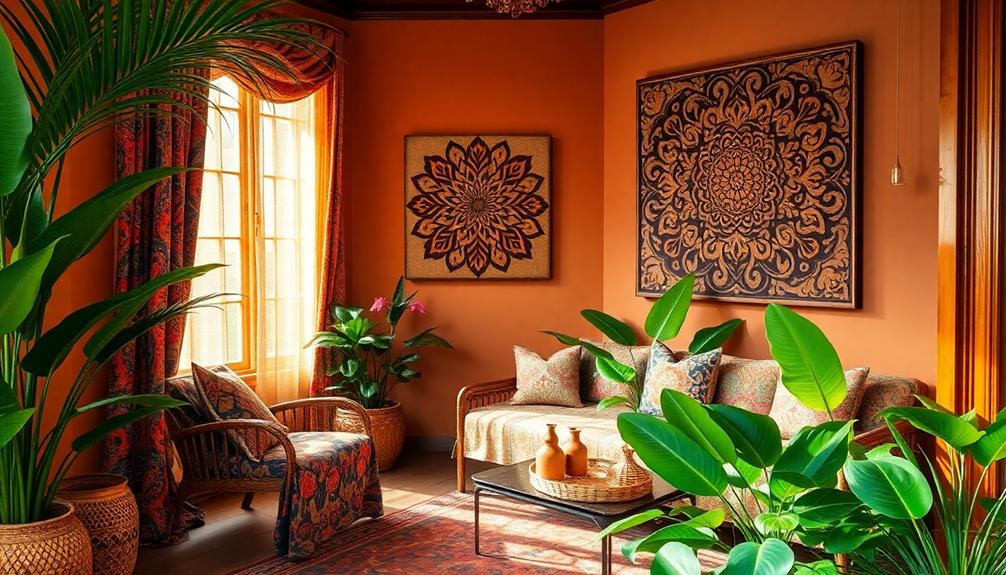
Batik, an enchanting traditional Indonesian textile art form, employs a wax-resist dyeing technique to create intricate patterns that often reflect nature and cultural narratives. This textile art has gained recognition as a UNESCO Intangible Cultural Heritage of Humanity, highlighting its importance in preserving cultural heritage.
Alongside batik, other traditional art forms like Indonesian decor masks also celebrate the rich cultural history of Indonesia. You'll find that batik's versatility shines in various home decor items, like pillowcases, tablecloths, and curtains, allowing you to seamlessly blend tradition with contemporary aesthetics.
Incorporating batik motifs into your interior design can elevate the visual appeal of your spaces. Modern designers frequently adapt these intricate patterns, integrating them into different color palettes and textiles, making batik increasingly popular worldwide.
Whether you're looking to add a touch of heritage or simply want an eye-catching element in your decor, batik fits the bill. Using batik in your home showcases not only its beauty but also a respect for the cultural narratives it represents.
As you explore the world of interior design, consider how this traditional textile art can transform your living space while honoring the rich history and craftsmanship behind it. Embrace the art of batik, and let its story become part of your home.
Wayang Puppetry as Decor
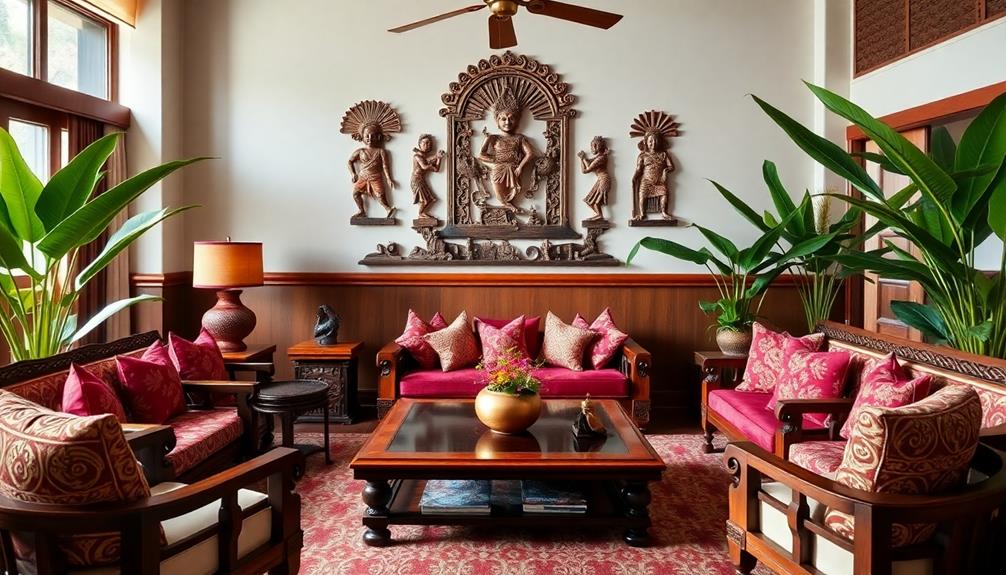
Wayang puppetry has a rich history that dates back to the 10th century in Java, making it a fascinating element to incorporate into your decor.
These puppets, crafted with intricate designs and vibrant colors, represent a key part of Indonesia's cultural heritage. Today, they aren't just for storytelling; they've become popular decorative pieces that reflect Indonesia's cultural heritage.
By showcasing Wayang Kulit or Wayang Golek in your home, you're adding a unique touch that tells a story while enhancing your space's aesthetic.
Additionally, Indonesian decor masks complement this theme perfectly, further enriching your interior design with traditional craftsmanship.
Historical Significance of Wayang
Often celebrated for its rich cultural heritage, Indonesian Wayang puppetry has found a remarkable place in contemporary interior design. Originating in Java during the 10th century, this decorative art form embodies deep-rooted Hindu influences and showcases intricate craftsmanship. The two main types, Wayang Kulit (leather) and Wayang Golek (wooden figures), each offer unique aesthetic qualities that enhance various interior spaces.
When you incorporate these puppets into your decor, you reflect a blend of traditional artistry and contemporary design. Here's a quick look at the significance of Wayang puppetry:
| Type | Unique Qualities | Decorative Uses |
|---|---|---|
| Wayang Kulit | Delicate leather craftsmanship | Wall art, sculptures |
| Wayang Golek | Vibrant wooden figures | Figurines, table decor |
| Historical | Deep cultural roots | Cultural heritage displays |
| Modern | Fusion with contemporary design | Unique conversation pieces |
Contemporary Decorative Applications
Incorporating Wayang puppetry into your home decor not only celebrates Indonesian culture but also adds a unique flair to modern interiors. This decorative art form, which originated in Java during the 10th century, has evolved beyond mere entertainment.
Featuring intricate designs, these puppets often depict local myths and folklore, enhancing the richness of your decor while promoting appreciation for Indonesian artistry and craftsmanship. You can enhance your interior settings with Wayang Kulit (leather) and Wayang Golek (wooden figures) as unique figurines or stunning wall art.
The intricate craftsmanship of these puppets showcases Indonesia's rich cultural heritage, making them perfect for adding depth and interest to your home decor. When displayed strategically, they can serve as artistic focal points, drawing attention and sparking conversations.
The global popularity of Wayang puppetry reflects a growing appreciation for authentic cultural elements in contemporary design.
The Beauty of Wood Carvings
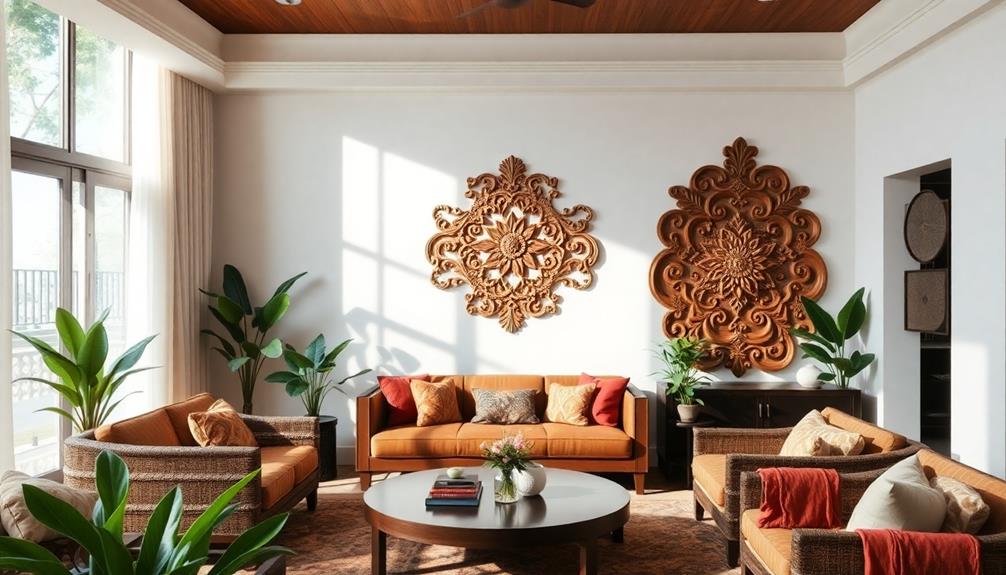
Wood carvings from Indonesia, especially those crafted in Bali and Jepara, captivate with their intricate designs and rich cultural heritage. These exquisite pieces often incorporate traditional motifs that celebrate the vibrant history of Indonesian art, showcasing the skill of local artisans.
You'll find that Indonesian wood carvings, particularly Balinese wood carvings, transform spaces into showcases of decorative art that reflect deep-rooted traditions. These pieces often draw inspiration from nature and mythology, making them not just decorative items but also storytellers of cultural heritage.
Indonesian art decor also highlights the importance of these carvings in contemporary designs. In contemporary interior design, these wood carvings serve as stunning wall art and furniture accents, adding a unique touch to any room. Their aesthetic appeal lies in the delicate craftsmanship that has been honed over centuries.
Each carving you bring into your home connects you to a legacy that merges artistry with purpose. Additionally, the growing interest in responsibly sourced timber makes these carvings even more desirable.
As you incorporate these exquisite pieces into your living space, you're not only enhancing your decor but also supporting sustainable practices. Embrace the beauty of Indonesian wood carvings and let them inspire a sense of harmony and elegance in your home.
Sustainable Materials in Design
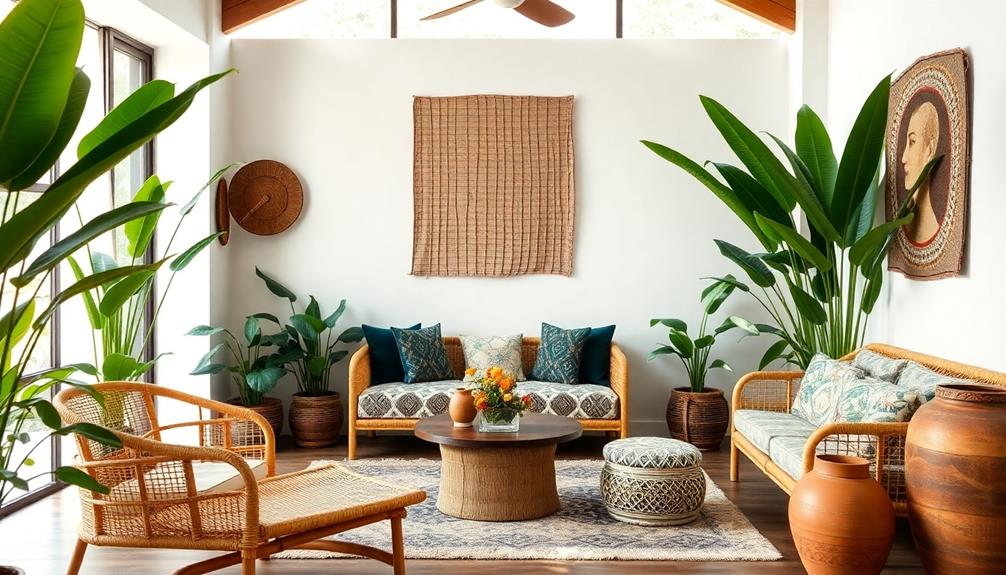
When it comes to sustainable materials in design, Indonesian craftsmanship shines through with options like rattan and bamboo. Sourced primarily from Cirebon, rattan is a highly sustainable material, with Indonesia producing around 400,000 tonnes annually. Its durability and weather resistance make it a top choice for outdoor furniture, elevating its status in international markets.
Additionally, incorporating traditional elements like Indonesian wedding decor ideas can further enhance the aesthetic and cultural richness of your space.
Incorporating sustainable materials not only benefits the environment but also enriches your interiors. Consider these elements:
- Rattan: Perfect for stylish and durable furniture.
- Bamboo: An eco-friendly alternative for various design applications.
- Batik: This ancient textile art, recognized by UNESCO, uses natural dyes and sustainable practices.
- Wood carvings: Sustainably sourced from Bali and Jepara, adding unique craftsmanship to your space.
- Natural dyes: Enhance textiles and decor while supporting eco-friendly practices.
Integrating Traditional and Modern Styles
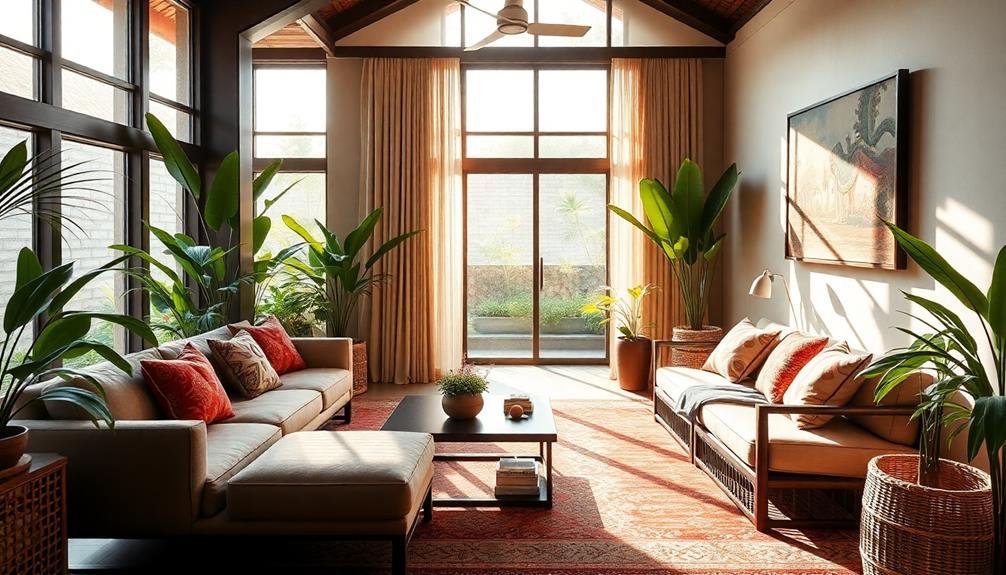
Blending traditional Indonesian styles with modern design principles creates a fascinating aesthetic that honors heritage while embracing contemporary living. You can achieve this by integrating traditional designs like batik textiles and intricate wood carvings into your interior design.
These elements not only celebrate cultural heritage but also add depth and character to your space. Additionally, incorporating natural materials such as wood and bamboo can enhance the connection to nature, as seen in traditional Indonesian style home decor.
Consider incorporating rattan furniture, known for its durability and versatility. It's a stylish choice that brings a touch of luxury while supporting sustainable practices.
To enhance visual interest, you might display Wayang puppets as decorative art pieces, showcasing their cultural significance and adding a unique focal point.
Furthermore, the combination of traditional art forms with minimalist design allows you to focus on fewer, high-quality pieces that reflect Indonesian craftsmanship. This approach emphasizes the beauty of simplicity while maintaining a strong connection to traditional roots.
You'll also find that earthy color palettes inspired by traditional motifs harmonize well with modern aesthetics. This blend not only creates a warm, inviting atmosphere but also infuses your home with a sense of cultural authenticity.
Embrace these elements for a truly enchanting interior.
Color Schemes Inspired by Culture
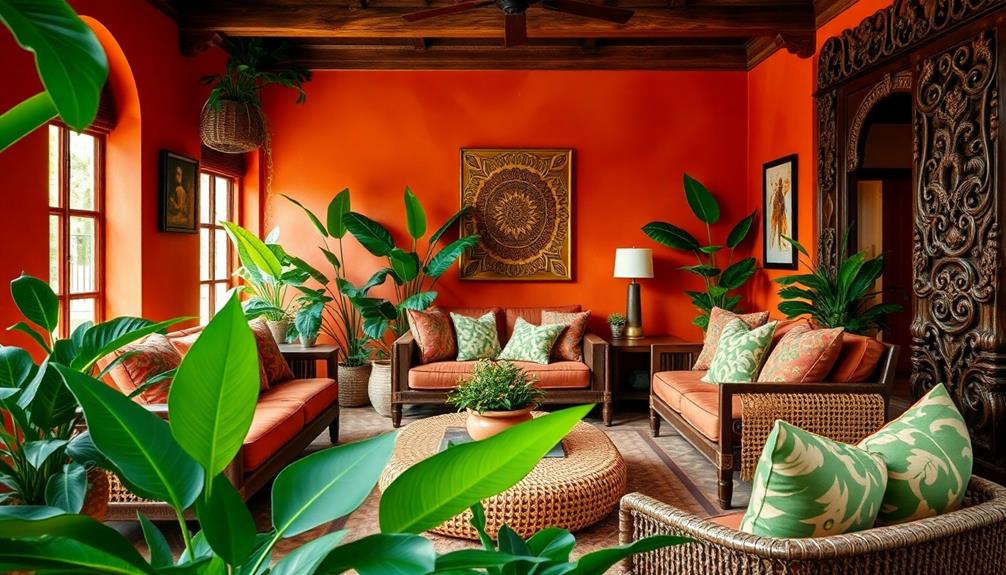
Drawing inspiration from Indonesia's rich cultural heritage, color schemes play a significant role in creating an inviting atmosphere within your home.
By carefully selecting a color palette, you can blend traditional elements with contemporary Indonesian interiors. Custom interior solutions from experts like Mahallati Interiors can help you achieve this balance.
Start with earthy tones like brown, beige, and green to establish a serene foundation that reflects nature. Then, introduce vibrant accents to enhance visual interest.
Consider these key elements when designing your color scheme:
- Use deep red, gold, orange, and turquoise for vibrant pops.
- Incorporate white to symbolize purity and spiritual balance.
- Feature black to represent wisdom and depth.
- Choose yellow for prosperity and fertility, invoking positive energy.
- Add intricate patterns through textiles like batik and ikat for cultural significance.
Nature-Inspired Design Elements
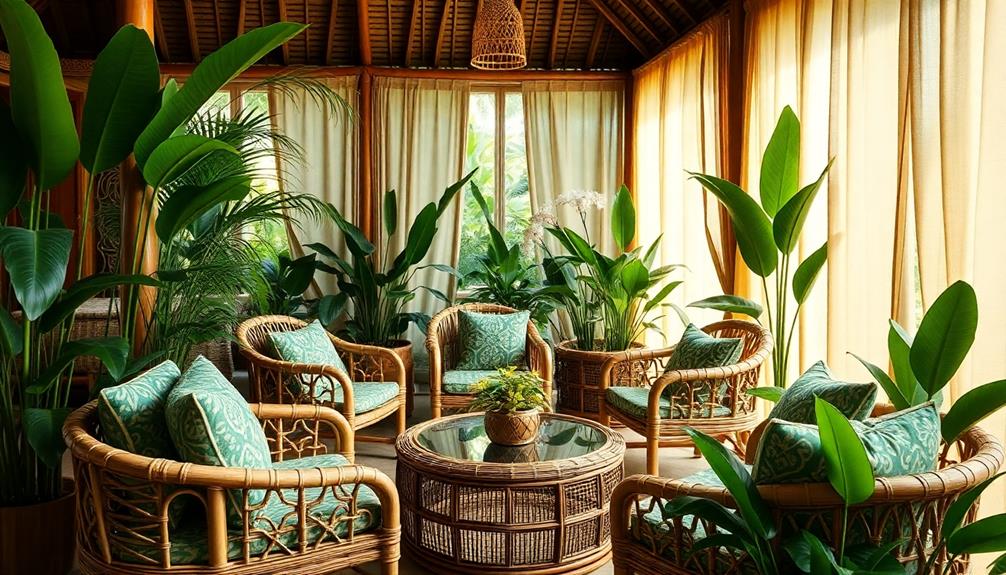
Incorporating nature-inspired design elements into your Indonesian interior can transform your space into a peaceful retreat. Start by introducing indoor plants like palms and ferns, which not only enhance visual interest but also improve air quality.
Think about adding water features, such as ponds or fountains, to create a tranquil atmosphere with the soothing sounds of flowing water. These features resonate with the traditional Indonesian emphasis on nature, as seen in the architectural styles of Rumah Adat, which often harmonize with their surroundings.
Utilize natural materials like wood, rattan, stone, and bamboo to add warmth and texture, promoting sustainability in your design. These materials connect your space to the natural world while providing a sense of authenticity.
Embrace open spaces and large windows to maximize natural light and seamlessly integrate indoor and outdoor areas, giving your home a breezy, spacious feel.
For your color palette, lean toward earthy tones like browns and greens, complemented by vibrant accents that reflect Indonesia's lush landscapes. This combination creates a harmonious environment that feels both grounded and lively.
The Influence of Balinese Aesthetics
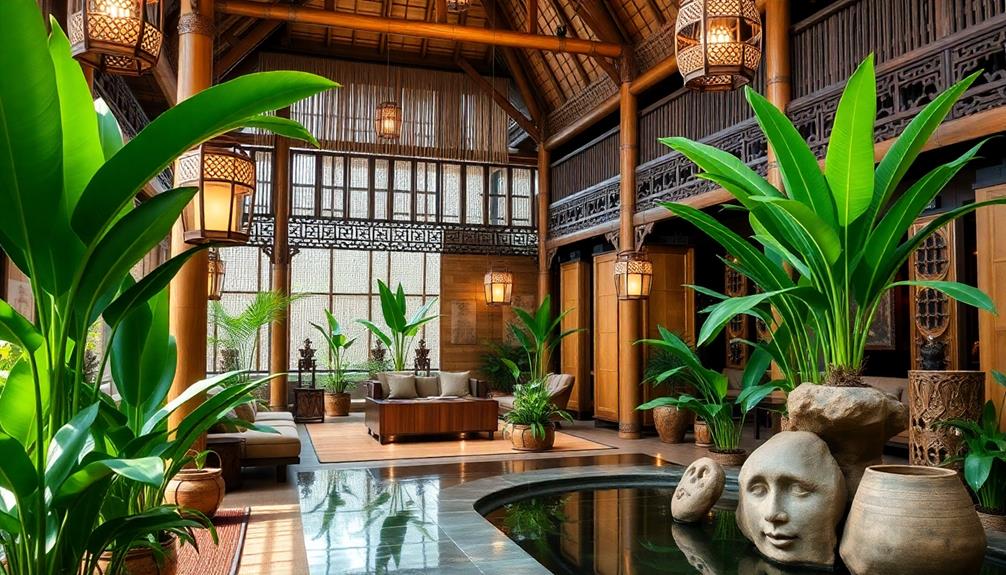
Emphasizing natural beauty and cultural richness, Balinese aesthetics offer a unique approach to interior design that invites serenity into your home.
By integrating elements that reflect the island's cultural heritage, you create spaces that are both warm and inviting. This design philosophy not only enhances the visual appeal of your interiors but also promotes sustainability and eco-friendly practices, echoing the essence of modern tropical aesthetics in Bali.
To embrace Balinese aesthetics, consider the following elements:
- Natural materials: Use wood, stone, and bamboo to construct a strong foundation for your interiors.
- Intricate hand-carved furniture: Invest in durable teak pieces that showcase detailed craftsmanship, adding character to your space.
- Open-air designs: Blur the lines between indoor and outdoor areas to enhance natural ventilation and promote a tranquil atmosphere.
- Earthy tones and vibrant accents: Choose a palette of browns and greens, accented with deep reds and golds, to embody cultural symbols and values.
- Nature-inspired elements: Incorporate indoor plants and water features to foster a deep connection with the natural environment, enhancing the overall serenity of your home.
Celebrating Indonesian Heritage in Interiors
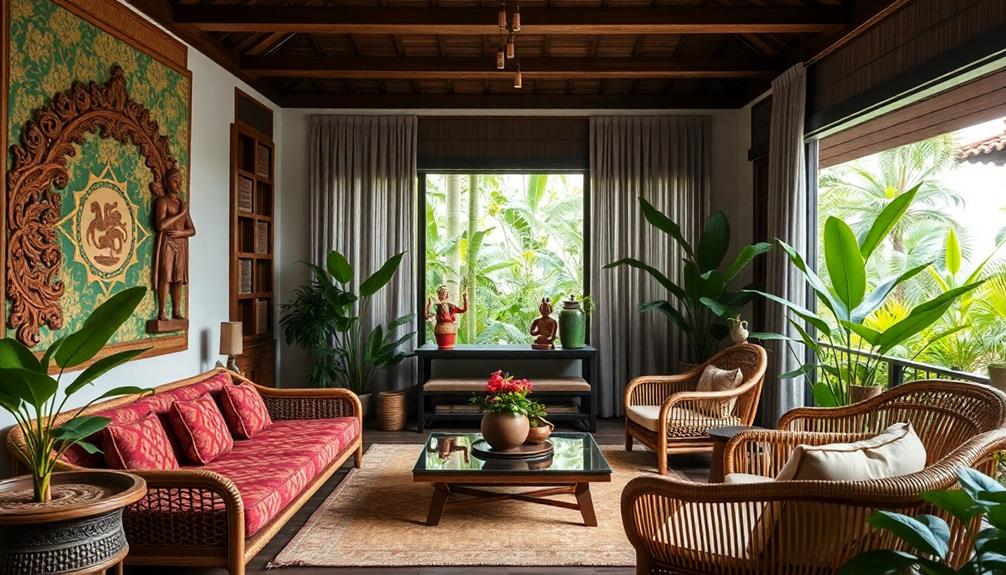
Incorporating traditional materials and techniques into your interiors can truly celebrate Indonesian heritage.
By using elements like bamboo, stone, and rattan, you're not just enhancing your space but also honoring the craftsmanship passed down through generations.
Plus, integrating cultural art forms, like batik patterns and wayang puppets, adds unique character and a rich narrative to your home.
Traditional Materials and Techniques
As you explore the rich tapestry of Indonesian culture in interior design, you'll find that traditional materials and techniques play a pivotal role in creating authentic spaces. By incorporating these elements, you can celebrate Indonesia's cultural heritage while enhancing your interior spaces.
Consider integrating the following traditional materials and techniques:
- Rattan: Its durability and weather resistance make it perfect for both indoor and outdoor furniture.
- Batik: This intricate textile art can enhance upholstery and decorative textiles with unique patterns.
- Wood carvings: Renowned for their craftsmanship, these pieces often serve as stunning focal points in your home.
- Wayang puppets: Shifting from entertainment to art, these puppets add cultural flair and significance to your decor.
- Craftsmanship: The skilled techniques used in these traditional materials reflect a deep respect for Indonesian artistry.
Blending these traditional materials with contemporary design creates a unique aesthetic that honors Indonesia's rich cultural heritage.
Cultural Art Forms Integration
Cultural art forms are essential in celebrating Indonesia's rich heritage within modern interior design. By integrating these elements, you not only beautify your space but also honor the diverse traditions of various ethnic groups. Here are some key art forms that can enhance your interiors:
| Cultural Art Form | Description |
|---|---|
| Wayang Puppetry | Use figurines and wall art as decorative elements, showcasing this traditional art. |
| Batik Patterns | Incorporate vibrant textiles for upholstery, cushions, and wall hangings, reflecting Indonesia's artistic traditions. |
| Indonesian Wood Carvings | Feature intricate designs as statement pieces, enhancing aesthetic appeal in your home. |
| Rattan Furniture | Add durable and luxurious furniture that promotes sustainability while infusing cultural essence. |
| Cultural Motifs | Blend techniques from various ethnic groups to create unique, enriched spaces. |
Frequently Asked Questions
What Are the Cultural Elements of Indonesia?
You'll find Indonesia's cultural elements are rich and varied, featuring influences from diverse ethnic groups. Notable aspects include traditional fabrics like batik, intricate wood carvings, and vibrant art forms like wayang puppetry that tell compelling stories.
What Are the Elements of Interior Design Style?
Interior design style includes color schemes, furniture selection, layout, lighting, and decorative elements. You'll create a cohesive look by balancing these components, ensuring they reflect your personality and meet your functional needs in the space.
What Is Bali's Interior Design Style?
Bali's beautiful interior design blends natural materials, open spaces, and vibrant textiles. You'll love the earthy tones and serene plants, creating a peaceful paradise that invites relaxation and reflects the island's rich cultural heritage.
What Are the Values of Indonesian Culture?
Indonesian culture values harmony, spirituality, community, and sustainability. You'll notice these traits in everyday life, as they foster connections among people, promote eco-friendly practices, and emphasize peaceful environments that reflect deep cultural traditions and beliefs.
Conclusion
Incorporating elements of Indonesian culture into interior design not only enhances aesthetic appeal but also tells a rich story. Did you know that over 50% of homeowners are now opting for sustainable materials in their spaces? By blending rattan, batik, and traditional wood carvings, you're not just decorating; you're celebrating a vibrant heritage. Embrace these cultural elements to create a unique and inviting environment that reflects both beauty and sustainability. It's a fusion worth exploring!
